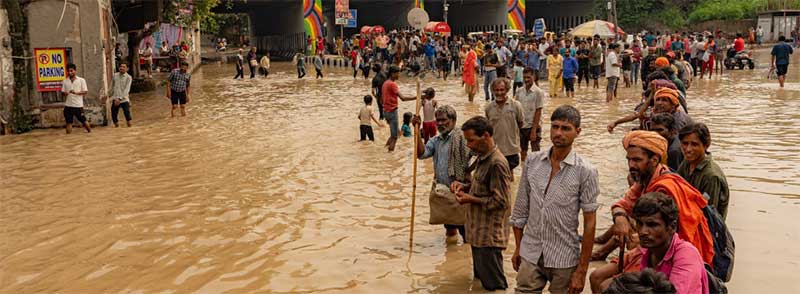 Flood
Flood
Behind Delhi’s floods is a history of encroachment and diminishing wetlands
Of Delhi’s 1,040 wetlands and waterbodies, none have been officially notified, leaving them vulnerable to exploitation. The city’s drainage plan and system have not been updated since the 1970s. This along with encroachment of the Yamuna floodplains by settlements and large development projects make the city vulnerable to flooding. Experts strongly recommend reviving the city’s water bodies and desilting its existing drains to help mitigate flood effects. Mongabay India writer Simrin Sirur reports
Of Delhi’s 1,040 wetlands and waterbodies, none have been officially notified, leaving them vulnerable to exploitation.
The city’s drainage plan and system have not been updated since the 1970s. This along with encroachment of the Yamuna floodplains by settlements and large development projects make the city vulnerable to flooding.
Experts strongly recommend reviving the city’s water bodies and desilting its existing drains to help mitigate flood effects.
When parts of Delhi were inundated with floodwaters several meters high in early July, several reports said that the river Yamuna was reclaiming its path. The river stretches across 48 kilometers of the city, and swelled above the danger mark on July 10, leaving damages worth over Rs. 10,000 crores in its wake, according to early estimates.
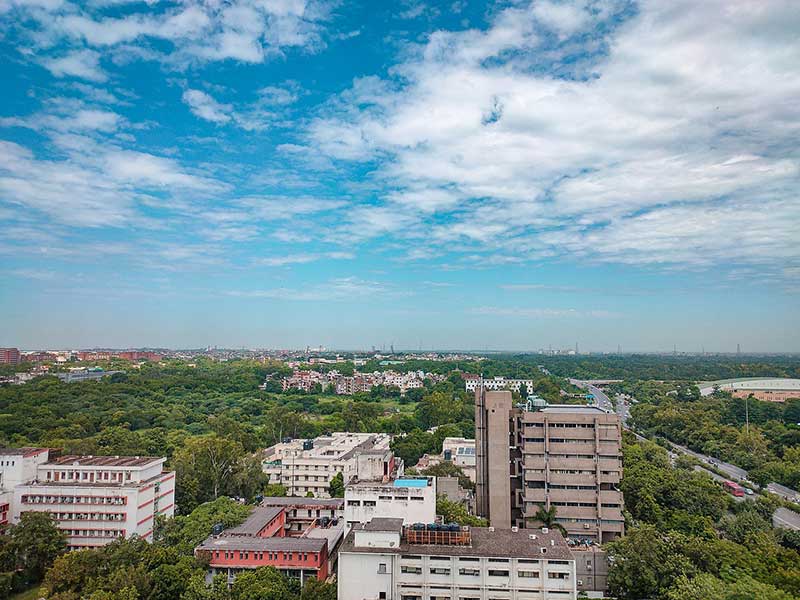 View from the 14th Floor, Vikas Minar, ITO that once used to be the Yamuna Floodplains. Photo by Vishal/Wikimedia Commons
View from the 14th Floor, Vikas Minar, ITO that once used to be the Yamuna Floodplains. Photo by Vishal/Wikimedia Commons
Compelling as the idea of river reclamation is, experts say the floods are, however, an urgent indication to improve the city’s drainage systems. They also point to Delhi’s diminishing natural line of defence — its water bodies and wetlands — against such hazards, without which the river cannot drain its water naturally.
"The biggest wetland in Delhi is the Yamuna floodplain, which has slowly been taken over [by urban development],” said Ritesh Kumar, director for Wetlands International South-Asia (WISA). “Two processes are occurring in Delhi which make it flood prone — first, more and more surface is being concretised and covered, creating more runoff, and secondly, there are [increasing] weather impacts that the landscape is incapable of handling well."
The Yamuna’s floodplain in Delhi is around 97 square kilometres, or 7% of the city’s area, according to the Delhi Development Authority’s 2021 Master Plan for the city. But much of this has been encroached upon by settlements and large development projects which have hindered its free flow.
The city’s 2041 Master Plan proposes to regularise some of these settlements and projects by allowing “regulated development” along the ‘O’ zone of the river, considered prone to flooding, which could worsen the city’s resilience to such disasters.
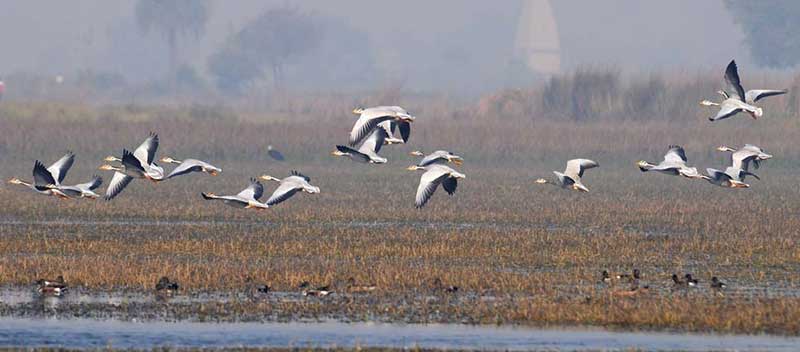 Wetlands act as natural sponges, absorbing excess rainfall and mitigating floods, providing cities with invaluable flood protection and host a lot of biodiversity. Photo by Koshy/Wikimedia Commons
Wetlands act as natural sponges, absorbing excess rainfall and mitigating floods, providing cities with invaluable flood protection and host a lot of biodiversity. Photo by Koshy/Wikimedia Commons
While excess water released from a nearby barrage, an aging drainage system, and heavy rainfall were some of the immediate triggers for the flooding last week, the gradual erosion of Delhi’s wetlands and the Yamuna floodplain have also contributed to the city’s vulnerability, show studies.
Role of wetlands in flood management
Wetlands can be of many different kinds, including lakes, marshes, river floodplains, and swamps, to name a few. They can also be artificial structures built for specific purposes, like reservoirs and aquaculture ponds.
“Wetlands are slow waters. Once water enters them, it starts to release sediment and it gets an accommodating space to spread. The force of the water is reduced significantly and blunts out the hydrograph,” explained Kumar.
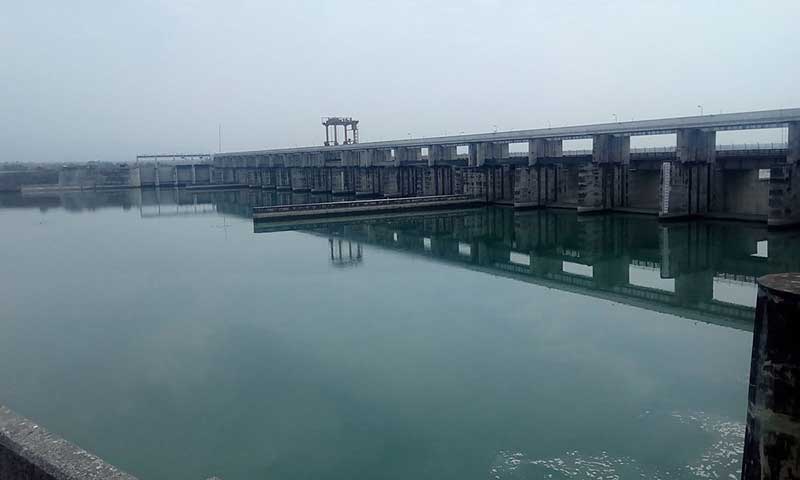 The release of water from the Hathnikund barrage has sparked a dispute between the governments of Haryana and New Delhi. Photo by Owais Khursheed/Wikimedia Commons
The release of water from the Hathnikund barrage has sparked a dispute between the governments of Haryana and New Delhi. Photo by Owais Khursheed/Wikimedia Commons
A 2021 modeling study from a proposed constructed wetland in the north-west part of Delhi found that it could lead to an overall reduction of 23% in flooding, “with a significant reduction in backflow as well as water depth in the drain.”
Apart from regulating the speed and volume of water, wetlands also perform a host of other ecological functions. They host a diversity of species, recharge groundwater, and reduce downstream erosion.
Delhi has a total of 1,040 wetlands and waterbodies, according to the city’s Wetland Authority. But none of them have been officially notified yet, leaving them vulnerable to exploitation. A report in The Hindu revealed that the Wetlands Authority received requests from agencies to delist over 200 wetlands, because they have dried up or been encroached upon.
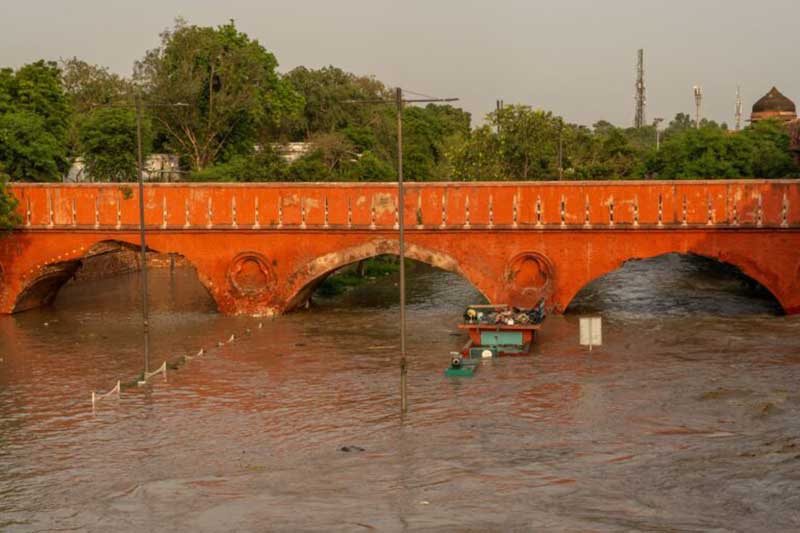 Delhi’s drainage plan and system have not been updated since the 1970s. . Photo by Shaz Syed/Mongabay.
Delhi’s drainage plan and system have not been updated since the 1970s. . Photo by Shaz Syed/Mongabay.
“The National Capital Region presents a unique scenario because it has so many wetlands along with a river flowing through it,” said Madhu Verma, an environmental economist with Iora Ecological Solutions, who chairs a technical committee advising the Delhi Wetlands Authority. “We are in the process of notifying some wetlands. Without notification, there can be no planning and funds cannot be allocated for their protection.”
Encroachment of wetlands
Shortly after the floodwaters breached the danger mark this month, the governments of Delhi and Haryana engaged in a dispute over water released from the old Hathnikund barrage located in Haryana, built in 1996 to divert water into the eastern and western canals of the Yamuna. The Delhi government blamed the city’s flooding on the Haryana government’s decision to release excess water directly into the river, as opposed to the canals. The Haryana government retaliated by saying it had merely followed prescribed norms when the river’s flow exceeded 1 lakh cusecs. On July 10, the peak discharge from the barrage was 3.59 lakh cusecs.
To make matters worse, floodgates in the heart of the city in ITO were reportedly jammed, exacerbating the flooding.
According to Himanshu Thakkar, coordinator of the South Asia Network on Dams, Rivers and People (SANDRP), the water released from the Hathnikund barrage does not explain the extent of flooding the city saw last week, which he attributes to gradual obstructions in the river, concretisation of the floodplains, and destruction of water bodies within the city.
“In 2010, water released from the Hathnikund barrage exceeded 7 lakh cusecs, but water levels never breached 207.49 meters, a record level set in 1978. Three years later, over 8 lakh cusecs were discharged into the river, and still we did not see this level of flooding. Now, with only 3 lakhs of discharge, flood records have been broken. This can only mean that factors within Delhi are the reason,” he said.
Lakhs of people live on the floodplains of the Yamuna in the city, several of whom have converted the area to agricultural fields to make a livelihood. The Akshardham temple, which had a daily footfall of 6,000 before the COVID-19 pandemic, was built in 2000 on the floodplain with post-facto environmental clearance. The posh Commonwealth Games Village in 2010 too came up on the floodplains.
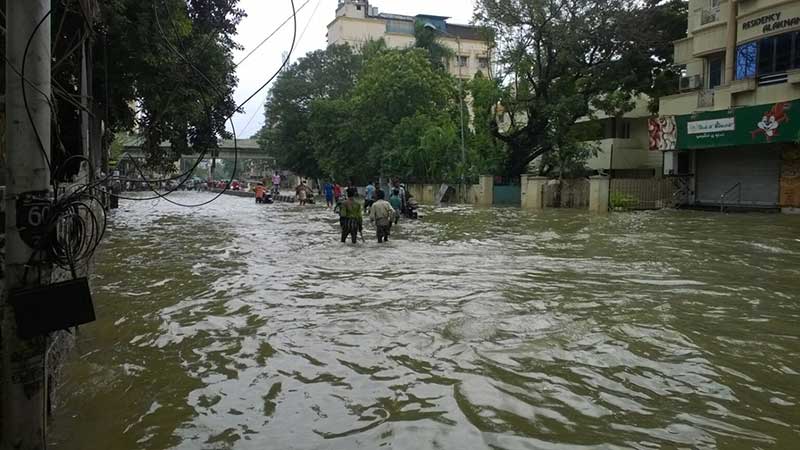 A flooded street in Chennai Flood, Nandanam. Representative image. Photo by Vijayingarsal/Wikimedia Commons
A flooded street in Chennai Flood, Nandanam. Representative image. Photo by Vijayingarsal/Wikimedia Commons
According to a report by the Centre for Science and Environment, the Yamuna floodplain had over 600 wetlands and waterbodies, but “more than 60% of them are without water, making the city prone to flooding.” The report further states that “the river-fed water bodies in the Yamuna floodplain are disconnected from the river because of embankments.”
Economist Verma says the destruction of floodplains and waterbodies stems from a systematic undervaluation of nature’s ecological services.
“It is so much more damaging and expensive when an event like this occurs, costing thousands of crores. It is much more economical to conserve these ecosystems which give us benefits in the long run,” she said.
Repairing drains and reviving waterbodies
Delhi has at least 21 drains that are connected to the Yamuna, according to A.K. Gosain, a professor with the Department of Civil Engineering at the Indian Institute of Technology, Delhi. Gosain was part of a group that drafted a 2018 drainage plan to replace the city’s current ailing system, which hasn’t been updated since the 1970s.
What made the flooding particularly bad this time was not just heavy rainfall over the city, but a swollen river that itself blocked regular drainage pathways, Gosain explained.
The 2018 draft plan recommended desilting existing drains to improve efficiency and reviving wetlands and water bodies to improve drainage in the city.
“Wetlands and waterbodies help mitigate local flooding because they also act as storage spaces. If a waterbody can hold flood water temporarily, it prevents that much more from going into the drain,” said Gosain.
The Delhi government rejected the 2018 draft plan, calling it “generic” in its approach, but has failed to finalise a drainage plan for the city to date.
Some pockets of the city are seeing a revival of water bodies and wetlands, but not nearly at the scale required, say experts.
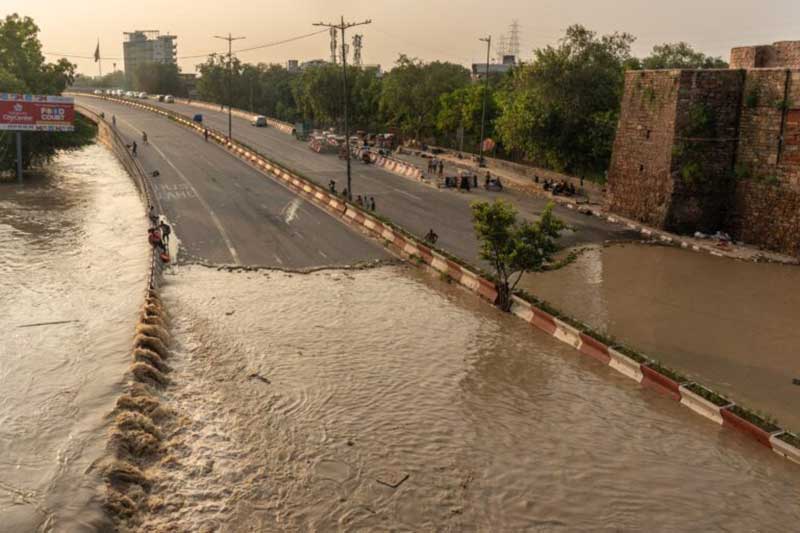 Wetlands and waterbodies act as a storage space that can help in mitigating local flooding. Photo by Shaz Syed/Mongabay.
Wetlands and waterbodies act as a storage space that can help in mitigating local flooding. Photo by Shaz Syed/Mongabay.
One such pocket is the Delhi Development Authority’s Yamuna Biodiversity Park, which is located alongside the river. Park authorities have worked to revive an active floodplain of the Yamuna river since 2009, and looked at 20-25 year old data on the river’s “flood pulse” to chart a course of action.
The floodplain is no simple system, said senior scientist at the park, Faiyaz Khudsar, who has worked here since 2005. There are several zones within the floodplain that have to be carefully studied before restoration efforts begin, he said.
“After the river channel, there is a riparian zone, then an active floodplain, then an alluvial floodplain. All these zones and their ecological integrity have to be carefully considered, because that’s what makes a river functional,” he said, adding that the park had revived a wetland by planting grass species like phragmites and Saccharum spontaneum, which remain intact through floods.
“We shouldn’t see a river’s flood as a curse,” said Khudsar. “If we have characteristic grasses along the river, and riparian zone vegetation, then the river moves more smoothly.”
Support Our Journalism
We cannot do without you.. your contribution supports unbiased journalism
IBNS is not driven by any ism- not wokeism, not racism, not skewed secularism, not hyper right-wing or left liberal ideals, nor by any hardline religious beliefs or hyper nationalism. We want to serve you good old objective news, as they are. We do not judge or preach. We let people decide for themselves. We only try to present factual and well-sourced news.







